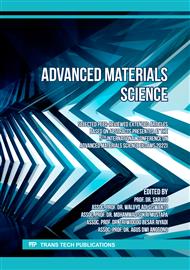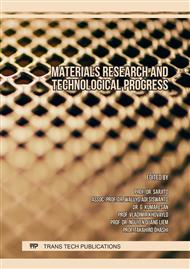[1]
S. Khireche, D. Boughrara, A. Kadri, L. Hamadou, and N. Benbrahim, Corrosion mechanism of Al, Al-Zn and Al-Zn-Sn alloys in 3wt.% NaCl solution,, Corros. Sci., vol. 87, p.504–516, 2014,.
DOI: 10.1016/j.corsci.2014.07.018
Google Scholar
[2]
J. Tao, 'Surface composition and corrosion behavior of an Al-Cu alloy,', p.180, (2016).
Google Scholar
[3]
Tong Xi, M. Babar Shahzad, Dake Xu, Ziqing Sun, Jinlong Zhao, Chunguang Yang, Min Qi, Ke Yang, Effect of copper addition on mechanical properties, corrosion resistance and antibacterial property of 316L stainless steel,, Mater. Sci. Eng. C, vol. 71, p.1079–1085, 2017,.
DOI: 10.1016/j.msec.2016.11.022
Google Scholar
[4]
W. Suprapto, R. Soenoko, and F. Gapsari, Comparation of the analytical and experimental models of 304SS corrosion rate in 0.5 M H2SO4 with bee wax propolis extract,, Eng. Rev., vol. 38, no. 2, p.182–188, 2018,.
DOI: 10.30765/er.38.2.6
Google Scholar
[5]
Y. P. Asmara and T. Kurniawan, Corrosion prediction for corrosion rate of carbon steel in oil and gas environment: A review,, Indones. J. Sci. Technol., vol. 3, no. 1, p.64–74, 2018,.
DOI: 10.17509/ijost.v3i1.10808
Google Scholar
[6]
S. G. Bratsch, Standard Electrode Potentials and Temperature Coefficients in Water at 298.15 K,, J. Phys. Chem. Ref. Data, vol. 18, no. 1, p.1–21, 1989,.
DOI: 10.1063/1.555839
Google Scholar
[7]
R. Wang, D. Wang, H. Nagaumi, Z. Wu, X. Zhang, and X. Li, Effect of Zn content on corrosion resistance of as-cast Al-6Si-3Cu alloy,, Mater. Lett., vol. 312, no. October 2021, p.131658, 2022,.
DOI: 10.1016/j.matlet.2022.131658
Google Scholar
[8]
Q. Meng and G. S. Frankel, Effect of Cu Content on Corrosion Behavior of 7xxx Series Aluminum Alloys,, J. Electrochem. Soc., vol. 151, no. 5, p. B271, 2004,.
DOI: 10.1149/1.1695385
Google Scholar
[9]
F. Sato and R. C. Newman, Mechanism of activation of aluminum by low-melting point elements: Part 2 - Effect of zinc on activation of aluminum in pitting corrosion,, Corrosion, vol. 55, no. 1, p.3–9, 1999,.
DOI: 10.5006/1.3283964
Google Scholar
[10]
S. Arthanari, J. C. Jang, and K. S. Shin, Corrosion studies of high pressure die-cast Al-Si-Ni and Al-Si-Ni-Cu alloys,, J. Alloys Compd., vol. 749, p.146–154, 2018,.
DOI: 10.1016/j.jallcom.2018.03.246
Google Scholar
[11]
M. Fontana, Corrosion Engineering, Third. Ohio: McGraw-Hill Series in Materials Science and Engineering, (1987).
Google Scholar
[12]
C. Resistance, Robert G. Kelly, John R. Scully, David W. Shoesmith, Rudolph G. Buchheit , Electrochemical Techniques in Corrosion Sci,.
DOI: 10.1002/cphc.200390088
Google Scholar
[13]
M. Sarvghad-Moghaddam, R. Parvizi, A. Davoodi, M. Haddad-Sabzevar, and A. Imani, Establishing a correlation between interfacial microstructures and corrosion initiation sites in Al/Cu joints by SEM-EDS and AFM-SKPFM,, Corros. Sci., vol. 79, p.148–158, 2014,.
DOI: 10.1016/j.corsci.2013.10.039
Google Scholar
[14]
H. Shi, E. H. Han, F. Liu, T. Wei, Z. Zhu, and D. Xu, Study of corrosion inhibition of coupled Al2Cu-Al and Al3Fe-Al by cerium cinnamate using scanning vibrating electrode technique and scanning ion-selective electrode technique,, Corros. Sci., vol. 98, p.150–162, 2015,.
DOI: 10.1016/j.corsci.2015.05.019
Google Scholar
[15]
ASM International, ASM handbook volume 3: Alloy phase diagrams. (1998).
Google Scholar
[16]
M. Sahin, Joining of aluminium and copper materials with friction welding,, Int. J. Adv. Manuf. Technol., vol. 49, no. 5–8, p.527–534, 2010,.
DOI: 10.1007/s00170-009-2443-7
Google Scholar
[17]
Zhang, W. He, H. Du, and K. Yang, Microstructure, mechanical properties and corrosion properties of Mg-Zn-Y alloys with low Zn content,, Mater. Sci. Eng. A, vol. 488, no. 1–2, p.102–111, 2008,.
DOI: 10.1016/j.msea.2007.10.056
Google Scholar
[18]
S. Cai, T. Lei, N. Li, and F. Feng, Effects of Zn on microstructure, mechanical properties and corrosion behavior of Mg-Zn alloys,, Mater. Sci. Eng. C, vol. 32, no. 8, p.2570–2577, 2012,.
DOI: 10.1016/j.msec.2012.07.042
Google Scholar
[19]
S. Gudić, I. Smoljko, and M. Klikić, The effect of small addition of tin and indium on the corrosion behavior of aluminium in chloride solution,, J. Alloys Compd., vol. 505, no. 1, p.54–63, 2010,.
DOI: 10.1016/j.jallcom.2010.06.055
Google Scholar
[20]
W. R. Osório, C. M. Freire, and A. Garcia, The effect of the dendritic microstructure on the corrosion resistance of Zn-Al alloys,, J. Alloys Compd., vol. 397, no. 1–2, p.179–191, 2005,.
DOI: 10.1016/j.jallcom.2005.01.035
Google Scholar
[21]
G. F. Sperandio, C. M. L. Santos, and A. G. S. Galdino, Influence of silicon on the corrosion behavior of Al–Zn–In sacrificial anode,, J. Mater. Res. Technol., vol. 15, p.614–622, 2021,.
DOI: 10.1016/j.jmrt.2021.08.033
Google Scholar
[22]
B. Legendre, Y. Feutelais, J. M. San Juan, and I. Hurtado, Enthalpy of formation of the ternary τ' phase in the Al-Cu-Zn system,, J. Alloys Compd., vol. 308, no. 1–2, p.216–220, 2000,.
DOI: 10.1016/S0925-8388(00)00980-4
Google Scholar



